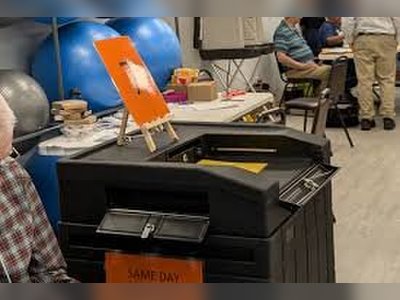This Is How the 'Heist of the Century' Was Carried Out at the Louvre in Seven Minutes: France Humiliated as Crown with 2,000 Diamonds Vanishes
A daylight robbery at the Louvre shocks France after masked thieves use a crane, saws, and motorcycles to steal imperial jewels worth tens of millions; investigators fear the historic treasures from Napoleon’s collection may already be melted down.
In one of the boldest art thefts in recent memory, a group of four masked robbers executed what French media have called the 'Heist of the Century' at the Louvre Museum in Paris.
The gang struck in broad daylight, taking just seven minutes to steal eight pieces of priceless jewelry from Napoleon’s imperial collection, including Empress Eugénie’s diamond crown adorned with nearly two thousand stones.
The heist, which occurred around nine-thirty in the morning—only half an hour after the museum opened—has left France reeling and authorities embarrassed.
Two of the thieves disguised themselves in yellow construction vests to pass as workers and used a freight crane parked along the Seine to reach the second-floor Apollo Gallery.
They cut through a window using a circular saw, threatened security guards, and smashed display cases containing rare imperial jewels.
When the museum alarm sounded, they fled on motorcycles, abandoning their tools after attempting, and failing, to set the crane on fire.
Among the stolen items were Empress Marie-Louise’s diamond and emerald necklace, gifted by Napoleon Bonaparte, and Empress Eugénie’s diadem, both considered masterpieces of 19th-century craftsmanship.
Also taken was Queen Marie-Amélie’s sapphire and diamond necklace.
One of Eugénie’s other crowns was later found broken outside the museum.
The largest gem in the collection—a one-hundred-forty-carat diamond valued at sixty million dollars—remained untouched.
French police launched an intensive investigation with sixty detectives, aided by an Israeli intelligence firm specializing in stolen art recovery.
Authorities fear the jewels may soon be melted down or dismantled, as experts warn that the first twenty-four to forty-eight hours after such a theft are critical.
Chris Marinello, head of Art Recovery International, noted that the thieves are unlikely to keep the jewels intact, saying they will probably melt the metals and recut the stones to erase evidence.
According to French media, the robbery lasted between four and seven minutes.
Culture Minister Rachida Dati described the operation as 'cold and professional,' saying the thieves showed no violence but executed a precise plan.
Panic erupted inside the museum as visitors ran for exits that failed to open immediately.
Police were later seen sprinting near the Louvre Pyramid.
The museum has remained closed for two consecutive days as forensic teams scour the site.
Justice Minister Gérald Darmanin admitted the incident represented a 'clear failure' of museum security, calling it a national embarrassment.
The thieves, he noted, had parked their crane truck in plain view on a public street.
Interior Minister Laurent Nuñez said the cultural value of the stolen pieces was 'beyond measure.'
Criticism quickly mounted over alleged security negligence and staff shortages.
Employees have long complained of overwork and insufficient guards, and in June, protests temporarily shut the museum over similar concerns.
While masterpieces like the Mona Lisa are heavily protected behind bulletproof glass, the incident revealed gaps in safeguarding less-famous but equally valuable artifacts.
Far-right politician Jordan Bardella accused President Emmanuel Macron of presiding over 'national humiliation' amid broader political turmoil.
He called the theft 'an unimaginable disgrace for our country' and a sign of France’s decline.
The attack comes as Macron promotes a seven-hundred-million-euro renovation of the Louvre, aimed at reducing overcrowding and giving the Mona Lisa its own gallery by 2031.
The Louvre, which draws nine million visitors a year—about thirty thousand daily—houses more than thirty-three thousand artworks.
Its history includes several notable thefts, including the 1911 stealing of the Mona Lisa by an Italian worker, later recovered in Florence.
The latest heist, experts warn, could eclipse even that infamous episode if the stolen jewels are lost forever.
The gang struck in broad daylight, taking just seven minutes to steal eight pieces of priceless jewelry from Napoleon’s imperial collection, including Empress Eugénie’s diamond crown adorned with nearly two thousand stones.
The heist, which occurred around nine-thirty in the morning—only half an hour after the museum opened—has left France reeling and authorities embarrassed.
Two of the thieves disguised themselves in yellow construction vests to pass as workers and used a freight crane parked along the Seine to reach the second-floor Apollo Gallery.
They cut through a window using a circular saw, threatened security guards, and smashed display cases containing rare imperial jewels.
When the museum alarm sounded, they fled on motorcycles, abandoning their tools after attempting, and failing, to set the crane on fire.
Among the stolen items were Empress Marie-Louise’s diamond and emerald necklace, gifted by Napoleon Bonaparte, and Empress Eugénie’s diadem, both considered masterpieces of 19th-century craftsmanship.
Also taken was Queen Marie-Amélie’s sapphire and diamond necklace.
One of Eugénie’s other crowns was later found broken outside the museum.
The largest gem in the collection—a one-hundred-forty-carat diamond valued at sixty million dollars—remained untouched.
French police launched an intensive investigation with sixty detectives, aided by an Israeli intelligence firm specializing in stolen art recovery.
Authorities fear the jewels may soon be melted down or dismantled, as experts warn that the first twenty-four to forty-eight hours after such a theft are critical.
Chris Marinello, head of Art Recovery International, noted that the thieves are unlikely to keep the jewels intact, saying they will probably melt the metals and recut the stones to erase evidence.
According to French media, the robbery lasted between four and seven minutes.
Culture Minister Rachida Dati described the operation as 'cold and professional,' saying the thieves showed no violence but executed a precise plan.
Panic erupted inside the museum as visitors ran for exits that failed to open immediately.
Police were later seen sprinting near the Louvre Pyramid.
The museum has remained closed for two consecutive days as forensic teams scour the site.
Justice Minister Gérald Darmanin admitted the incident represented a 'clear failure' of museum security, calling it a national embarrassment.
The thieves, he noted, had parked their crane truck in plain view on a public street.
Interior Minister Laurent Nuñez said the cultural value of the stolen pieces was 'beyond measure.'
Criticism quickly mounted over alleged security negligence and staff shortages.
Employees have long complained of overwork and insufficient guards, and in June, protests temporarily shut the museum over similar concerns.
While masterpieces like the Mona Lisa are heavily protected behind bulletproof glass, the incident revealed gaps in safeguarding less-famous but equally valuable artifacts.
Far-right politician Jordan Bardella accused President Emmanuel Macron of presiding over 'national humiliation' amid broader political turmoil.
He called the theft 'an unimaginable disgrace for our country' and a sign of France’s decline.
The attack comes as Macron promotes a seven-hundred-million-euro renovation of the Louvre, aimed at reducing overcrowding and giving the Mona Lisa its own gallery by 2031.
The Louvre, which draws nine million visitors a year—about thirty thousand daily—houses more than thirty-three thousand artworks.
Its history includes several notable thefts, including the 1911 stealing of the Mona Lisa by an Italian worker, later recovered in Florence.
The latest heist, experts warn, could eclipse even that infamous episode if the stolen jewels are lost forever.










